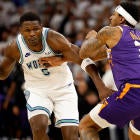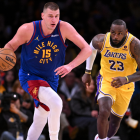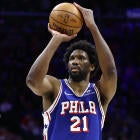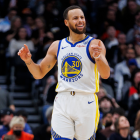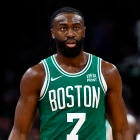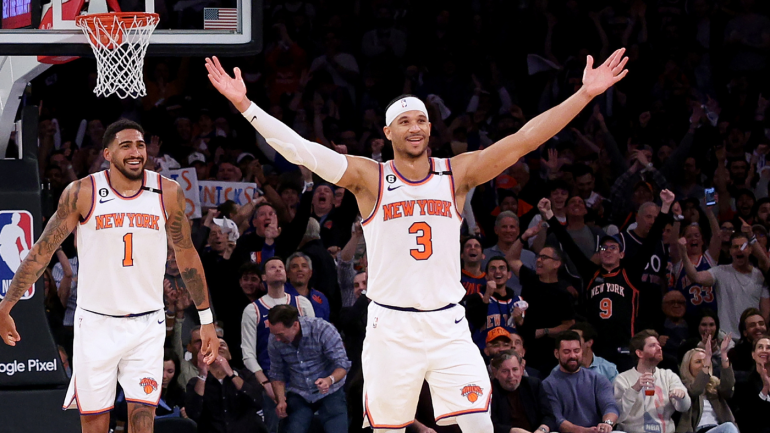
NEW YORK -- You can try to get the ball out of an elite scorer's hands, show them different coverages and attack them on the other end. Game-planning for a jack-of-all-trades role player like Josh Hart, however, is tricky.
"I think what he does at an elite level is he impacts winning," Cleveland Cavaliers coach J.B. Bickerstaff said on Sunday morning at Madison Square Garden, shortly before a first-round matinee against the New York Knicks.
Hart has a way of figuring out how to help his team, Bickerstaff said: "Some nights it's taking charges, some nights it's making shots." The Cavaliers need to "understand where he hurts you the most" and act accordingly: Put a body on him so he can't get offensive rebounds; take care of the ball and get back in transition because he's always trying to push it.
No one can stop a player like Hart from bringing his intangibles to the party, but Bickerstaff wanted his team to "keep him out of the stat sheet" in Game 4.
That didn't happen. Hart finished with 18 points, seven rebounds, two assists and two steals in 39 minutes, and his fingerprints were all over Donovan Mitchell's 5-for-18 showing. About halfway through the fourth quarter, he grabbed a defensive rebound, then went coast to coast and finished over Jarrett Allen Minutes later, he bailed out a frenzied possession by hitting a turnaround flip shot just before the shot clock expired.Then he grabbed an offensive board and found Jalen Brunson open for a 3.
"What can you say about Josh Hart?" New York coach Tom Thibodeau said after the 102-93 win. "Again, it's one tough play after the next. A big shot, big offensive rebound, great defense. The guy, he's just a winner."
Hart, acquired by the Knicks in February in a trade with Portland, isn't the reason why New York has a 3-1 lead in the series. But imagine if it were the Cavs who traded for him.
Playing with HART 🌃 pic.twitter.com/6oyE7EGdwC
— NEW YORK KNICKS (@nyknicks) April 23, 2023
In Cleveland's three losses, it has had an offensive rating of 102.1, 84.0 and, on Sunday, 103.3 points per 100 possessions, which is to say that it has been significantly less efficient in this series than any team was in the regular season. After a Game 3 defeat in which the Cavs became the first team to score fewer than 80 points in a game this season, Bickerstaff stressed the importance of ball movement and getting to the second side. Far too many times in Game 4, Cleveland got stagnant again.
Mitchell put all the blame on himself, and he deserves his fair share of it: He pounded the ball, initiated the offense too slowly and forced difficult shots. While he can make off-balance, contested pull-ups and stepback 3s in isolation, a healthy shot diet can't have too many of them.
The four-time All-Star needs to play more like Darius Garland did. When the Cavs went on an 18-7 run to take the lead early in the third quarter, Garland was forcing the defense to move, making quick decisions and nudging his team toward a faster halfcourt tempo. But neither Garland nor Mitchell are operating in an ideal offensive environment. Cleveland plays much of every game with both Allen and Evan Mobley on the floor, compromising its spacing, and the Knicks aren't particularly worried about its wings spotting up.
Hart, who did an excellent job navigating screens and pestering Mitchell one-on-one, called limiting Mitchell "a full team effort." He can defend aggressively because he knows that there is help behind him and the Cavs don't have shooters all over the court.
"We want to make him see bodies, close driving lanes and force him into taking tough 2s and stepback 3s and stuff like that," Hart said.
Similarly, Cleveland does not want Brunson, who finished with 29 points on 11-for-22 shooting, to get comfortable. It has blitzed him and showed him plenty of defensive attention. The Knicks have seen this coming, and they've done a better job than the Cavs of taking advantage of it. This, Thibodeau said, is a result of "everyone being connected together."
"Everyone has to get to the right spots and then you gotta make the right play and trust the game, trust your reads," Thibodeau said. "Don't fight it. Get off it, then move it to the back side and make plays from there. And that's what winning basketball is."
New York deserves credit for committing to doing that. It's easier to play winning basketball, though, with lineups that are cohesive at both ends. Hart and RJ Barrett, who had 26 points on 9-for-18 shooting, are dangerous attacking close-outs. They shot a combined 1 for 10 from 3-point range, but were clearly net positives.
Cleveland has two terrific playmakers in the backcourt and two young All-Defense types up front, but, as it was piling up regular-season wins, the question of who would start and close on the wing in the playoffs loomed. On Sunday, two days after pulling Isaac Okoro less than three minutes into Game 3, Bickerstaff removed him from the starting lineup. Caris LeVert took his place and Cedi Osman got some run, but Okoro wound up playing 17 minutes because he's the Cavs' best defensive option against Brunson
Okoro had a couple of successful drives to the basket, and he even made a sweeping hook over Obi Toppin early in the second quarter. At his best, he provides some of what Hart does. He rebounds extremely well for a 6-foot-5 wing, is dangerous in transition and, on the right night, he'll knock down a few open 3s. The Knicks simply don't guard him on the perimeter, though, and at this stage of his career he is not what you'd call a connector on offense. The Cavs don't have a reliable two-way wing on the roster.
Facing elimination, Cleveland could more consistently move the ball, play with pace and make Mitchell Robinson leave the paint in Game 5. It could also avoid getting dominated on the boards. Regardless of what happens in the rest of this series, though, the Knicks have a structural advantage: Ever since adding Hart, they've had the type of roster balance that allows a team to become more than the sum of its parts.
"He fit into the group perfectly," Thibodeau said.














